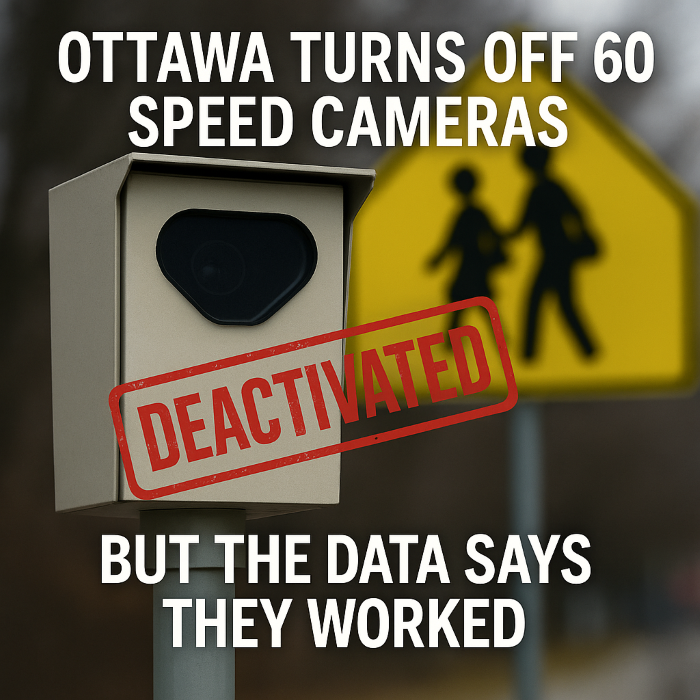A Diaspora Lens on the New $210 Million Plan to Stop Speeders
For anyone who has kids who walk to school, the debate about road safety is not political; it is personal.
For five years, Ottawa had a tool that, according to city data, was working. The 60 speed cameras in school zones and community safety areas were changing driver behaviour.
And then, on Friday, November 14, they were all switched off.
This wasn’t a city decision. The provincial government in Toronto ordered the cameras banned across all of Ontario.
The province says it has a better, fairer plan. But many, especially in our diaspora communities, are looking at this move with a familiar sense of confusion. We are left asking: Is this new plan truly about safety, or is it about politics?
Let’s break down the two sides of this story
Side 1: The City’s Case (The Data We Trusted)
For city officials and many parents, the math was simple: the cameras worked.
The City of Ottawa’s own data showed a massive success story:
- Behaviour Change: In areas with cameras, driver compliance (obeying the speed limit) jumped from just 16% to 81%.
- Reckless Driving: The most dangerous speeding (15 km/h or more over the limit) practically disappeared, dropping to less than 1%.
- Self-Funded Safety: The cameras raised over $80 million. By law, this money didn’t go to city hall offices; it was put directly back into road safety programs, like paying for school crossing guards.
Ottawa Police Chief Eric Stubbs said it plainly: “Losing them will have an impact… they do change behaviour.”
For many of us who came from places where government systems often don’t work, this was a Canadian success. It was a tool based on data, not opinion. It was on 24/7, protecting our kids
Side 2: The Province’s Case (The “Cash Grab” Argument)
So, why kill a system that worked?
The provincial government has a very different “lens.” Premier Doug Ford has repeatedly called the cameras a “cash grab” and a “tax” on drivers.
Their argument is this: a ticket that arrives in your mail two weeks after you were speeding doesn’t make the road safer in that moment. It just punishes the driver.
Instead, the province has banned the cameras and announced a new $210 million “Road Safety Initiatives Fund” for all municipalities. This money will be used for “physical” solutions, including:
- More speed bumps
- Raised crosswalks
- Flashing warning signs
- More funding for police to be “present” on the roads
The province says this is a better way. They point to a recent poll that found 80% of drivers say they do slow down for physical things like speed bumps.
A Diaspora Analysis: Data vs. Politics

This is where the story gets complicated and feels familiar. We are now watching a fight between “proven data” and “a new political promise.”
The Political Fight Mayors in big cities like Toronto and Ottawa are furious. Toronto’s mayor said their camera revenue paid for over 900 school crossing guards, funding that is now gone.
However, some other mayors, like the mayor of Vaughan, have actually welcomed the ban. The issue has divided the province.
A Familiar Pattern? For many in the African diaspora, this looks like “policy gymnastics.”
We see a working, data-driven system (the cameras) being scrapped. In its place, we see a massive $210 million fund for new construction and contracts.
It’s hard not to be skeptical. Back home, we often see big, expensive projects announced that sound good but don’t always fix the problem. We came to Canada expecting systems that follow evidence.
The core question for our community is:
What is more effective? A 24/7 camera that proves it can get 81% of people to slow down? Or a $210 million promise of speed bumps and flashing lights that might work?
For the parent walking their child to school, the fear is real. A camera was always watching. A police officer cannot sit in one school zone for 8 hours, and a speed bump cannot be put on every major road. Drivers knew the cameras were there. Now, they know they are gone.
What You Need to Know (The Simple Facts)
It is important to be clear about what is and is not happening.
- Are ALL cameras gone? No. The ban is only for the automated speed cameras (photo radar).
- Red-light cameras at intersections are STILL ON. You will still get a ticket if you run a red light.
- Community Safety Zones are still active. If a police officer catches you speeding in one, the fines are still doubled.
Final Thoughts: An Expensive Experiment
The government has traded a system that paid for itself for a $210 million experiment.
We are being told to trust that this new plan will work better than the 81% compliance rate the cameras gave us.
For diaspora communities who value the safety and reliability we came to Canada for, this is a major test. We can only hope this gamble with road safety pays off because the price, measured in the safety of our children, is too high to get wrong.


